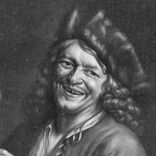
Pieter Gerritszoon van Roestraeten
From Haarlem to London: 17th-century Dutch painting found international recognition. Pieter Gerritszoon van Roestraeten, a native of Haarlem, even moved to England and witnessed the Great Fire of London. In the virtual museum of the fun part of art, we can see how painter Van Roestraeten perceived the world at that time and captured it vividly in his paintings.
The Life of Pieter van Roestraeten
Pieter van Roestraeten was born in 1630 in Haarlem. His father, Gerrit, possibly hailed from Leiden. His last name appears in various variants: Roesstraeten, Roestraten, and even Roelstraete. This confusion might indicate a distant origin, possibly in Flanders, or it could simply refer to the "Van der Houtstraat" (Houtstraat) in Haarlem.
In any case, Pieter van Roestraeten grew up in Haarlem, where he learned to paint under Frans Hals. He was under Hals' tutelage from 1646 to 1651 and maintained good contacts with the master even after that. In 1654, Pieter married Adriaentje, the daughter of Frans Hals. By that time, they were already living in Amsterdam. Interestingly, Adriaentje was six years older than him.
During his years in Amsterdam, Pieter van Roestraeten gained recognition as a versatile painter known for creating excellent portraits. In the 1660s, he had the opportunity to settle in England, specifically London. There, he shifted his focus to still lifes and genre paintings, as the portrait market was saturated. He achieved success and lived in prosperity.
Pieter van Roestraeten was injured during the Great Fire of London in 1666, and he would remain lame for the rest of his life. Nevertheless, he reached the relatively high age of 70 years old, not long after remarrying a younger woman following his first wife's passing.
Works by Pieter van Roestraeten
Pieter van Roestraeten specialized in genre paintings and still lifes, earning a comfortable living from these works. His art is rich in symbolism, often addressing weighty themes such as decay and death.
The themes Pieter van Roestraeten explored were those that preoccupied people in the late 17th century. Worldly wealth was abundant, yet it was seen as empty, "vain." It didn't necessarily lead to true happiness and didn't quite align with the prevailing religious beliefs of the time. Van Roestraeten masterfully depicted these contradictions, and in doing so, he became wealthy himself.
Pieter van Roestraeten possessed impeccable technical skills and was able to specialize in what he did best. His work is astonishingly detailed and undeniably "skillful," which was precisely what people were willing to pay for. In this regard, Pieter van Roestraeten can be aptly compared to the fine painters of Leiden.
Pieter Gerritszoon van Roestraeten & the fun part of art
Pieter van Roestraeten held up a mirror to his contemporaries. He understood what his clients were concerned about, how they viewed themselves and their wealth, and profited from it. It's a beautiful example of English irony: immensely wealthy people paying for paintings that mock their riches, while the artist himself becomes immensely wealthy. That irony is, for us, the fun part of art. Through the artworks in our virtual museum, we can gain a better understanding of the society of the 17th century.
